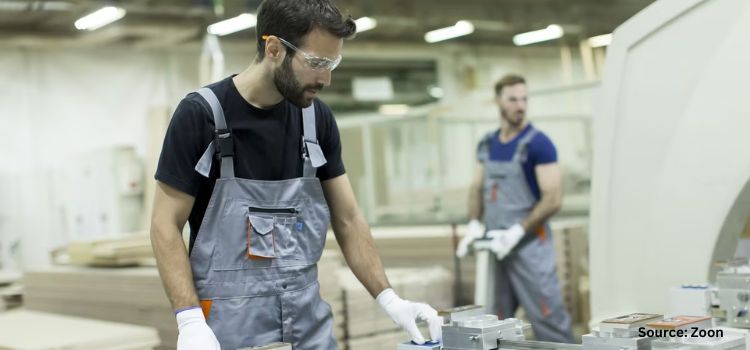
Bean Bag Chair Market by Product Type (Indoor Bean Bag Chairs (Standard Bean Bags, & Others), Outdoor Bean Bag Chairs (Waterproof Bean Bags, & Others), and Others), by Material (Cotton, & Others), by Size (Small, Medium, & Large), by Distribution Channel (Online (E-commerce Platforms, & Company Websites), Offline (Specialty Retail, & Department Stores)), and by End Users (Residential, Commercial (Offices, Gaming Lounges), and Others) –Global Opportunity Analysis and Industry Forecast 2025-2030
US Tariff Impact on Bean Bag Chair Market
Trump Tariffs Are Reshaping Global Business
Bean Bag Chair Industry Overview
The global Bean Bag Chair Market size was valued at USD 3.93 billion in 2024 and is predicted to reach USD 4.11 billion by the end of 2025. The industry is predicted to reach USD 5.10 billion by 2030 with a CAGR of 4.4% from 2025-2030.
The market is experiencing steady growth driven by its versatility, affordability, and ergonomic comfort. These chairs are lightweight, cost-effective, and adaptable to various settings such as homes, classrooms, and outdoor spaces. Their ability to conform to the body enhances relaxation and postural support, contributing to their popularity.
However, the use of non-biodegradable fillings like polystyrene poses environmental concerns, acting as a restraint to market expansion. In response, the growing demand for sustainable and eco-friendly materials presents a significant opportunity, enabling manufacturers to align with consumer preferences and strengthen their market position.
Rising Number of Co-working Spaces and Informal Work Environments Fuels the Market Growth
The rising number of co-working spaces and informal work environments, supported by government initiatives, is significantly driving the growth of the market. As businesses, particularly in tech and creative sectors, shift toward flexible and collaborative office designs, bean bag chairs are increasingly favored for their versatility, comfort, and aesthetic appeal. These chairs provide a casual seating option that fosters creativity, encourages spontaneous collaboration, and creates a relaxed atmosphere in co-working spaces, break rooms, and lounge areas. Their lightweight and portable nature allows for easy rearrangement to suit dynamic workspace needs, aligning with the trend of open-plan offices and informal work cultures.
Government programs, such as India’s Startup India initiative, which promotes entrepreneurship and flexible workspaces, have further fueled the expansion of co-working spaces, increasing the demand for adaptable furniture like bean bag chairs.
Similarly, policies in regions like Europe, where governments support innovation through startup funding, contribute to the proliferation of such work environments. This growing adoption in commercial settings, alongside the affordability and ergonomic benefits of bean bag chairs, is propelling their demand as a practical and stylish furniture solution for modern workspaces.
Digital Marketing and E-commerce Expansion Boost the Bean Bag Chair Market Growth
The expansion of digital marketing and e-commerce is significantly boosting the bean bag chair market demand by enhancing product visibility and accessibility. Online platforms leverage targeted digital campaigns, social media influencers, and SEO strategies to showcase the versatility, comfort, and modern appeal of bean bag chairs, appealing to millennials and Gen Z consumers who prioritize style and functionality. E-commerce platforms offer a wide range of designs, customization options, and competitive pricing, making casual seating furniture easily accessible to a global audience.
Government initiatives, such as the U.S. Small Business Administration’s support for digital transformation through grants and training programs for small businesses, have empowered furniture retailers to strengthen their online presence.
Similarly, India’s Digital India campaign, which promotes e-commerce growth and digital infrastructure, has facilitated the rise of online furniture marketplaces, enabling small and medium enterprises to market bean bag chairs effectively. This synergy of digital marketing innovation and e-commerce growth, supported by government policies, is driving increased consumer engagement and demand for bean bag chairs as a trendy and practical furniture choice.
Growing Construction of Residential and Commercial Spaces Propels the Market Growth
The growing construction of residential and commercial spaces is significantly fueling the demand for comfortable lounge chairs, as these versatile and stylish seating options align with modern interior design trends.
In residential settings, bean bag chairs are increasingly popular for their comfort, affordability, and ability to complement compact living spaces, appealing to urban dwellers and young families. In commercial spaces, such as offices, cafes, and recreational areas, their portability and casual aesthetic enhance flexible, open-plan environments that prioritize collaboration and relaxation.
Government initiatives, such as the U.S. Department of Housing and Urban Development’s programs promoting affordable housing development, have spurred residential construction, increasing the need for cost-effective furniture like bean bag chairs.
Similarly, India’s Smart Cities Mission, which supports urban infrastructure and commercial real estate development, has led to a surge in modern office and retail spaces, further driving the adoption of adaptable furniture solutions. This construction boom, supported by government policies, is amplifying the market by creating diverse applications for these functional and trendy seating options in both residential and commercial settings.
Environmental Concerns Over Traditional Fillings Restrain the Bean Bag Chair Market Expansion
Environmental concerns related to traditional bean bag fillings, such as polystyrene beads, pose another significant restraint on the market. Polystyrene is a non-biodegradable material that can contribute to environmental pollution. This has led to a growing demand for more sustainable and eco-friendly materials for bean bag fillings, such as recycled foam, natural fibers, or biodegradable alternatives. Addressing these environmental concerns through innovation and material choices is crucial for the long-term sustainability and growth of the bean bag industry.
Introduction of Eco-Friendly Bean Bags Creates Market Growth Opportunities
A significant opportunity for players in the industry lies in the development and adoption of sustainable and eco-friendly materials. As environmental awareness grows, consumers are increasingly seeking out products with a lower environmental impact. Manufacturers who invest in and promote the use of recycled, natural, or biodegradable fillings and sustainable fabric options can tap into this expanding market segment.
For instance, White Lotus Home’s organic bean bags, introduced in 2023, are made with shredded natural latex and GOTS-certified cotton covers, effectively catering to the rising demand for sustainable furniture. This shift toward eco-conscious products not only helps address environmental concerns but also presents notable growth potential, enhancing brand image and market share among environmentally aware consumers.
Market Segmentation and Scope of the Study
The bean bag chair market report is segmented on the basis of product type, material, size, distribution channel, end user, and region. On the basis of product type, the market is categorized into indoor bean bag chairs, outdoor bean bag chairs, and others. Indoor bean bag chairs are further segmented into standard bean bags, lounger bean bags, armchair bean bags, and gaming bean bags. Outdoor bean bag chairs are further segmented into waterproof bean bags, UV-resistant bean bags, and inflatable bean bags. On the basis of material, the market is divided into cotton, leather, faux leather, polypropylene, and others. On the basis of size, the market is segmented into small, medium, and large. On the basis of distribution channel, the market is categorized into online and offline. The online segment is further segmented into e-commerce platforms and company websites. The offline segment is further segmented into specialty retail, furniture stores, hypermarkets/supermarkets, and department stores. On the basis of end user, the market is segmented into residential and commercial. The commercial segment is further segmented into offices, cafes and restaurants, hotels and resorts, gaming lounges, and others. Regional breakdown and analysis of each of the aforesaid segments include regions comprising North America, Europe, Asia-Pacific, and RoW.
Geographical Analysis
In North America, the adoption of bean bag chair market share has been robust, largely driven by a strong inclination toward casual and comfortable home furnishings. Consumers in the United States and Canada often prioritize versatile and relaxed furniture solutions that suit open-plan living spaces, home offices, and family areas. This trend is further fueled by a growing emphasis on comfort and multifunctional furniture in modern interior design.
According to the U.S. Census Bureau, residential construction spending in the U.S. reached USD 963.8 billion in 2023, reflecting a strong housing market that supports demand for innovative home furnishings like bean bag chairs, particularly among millennials and Gen Z seeking affordable, stylish seating solutions.
In Europe, especially in countries like the United Kingdom and Germany, the market is witnessing evolving applications. Bean bags are increasingly used not only in residential settings but also in educational and commercial environments, such as classrooms, libraries, and coworking spaces. This shift reflects a growing recognition of the ergonomic and psychological benefits of informal seating arrangements, especially for younger demographics and creative workspaces.
The European Urban Initiative notes that approximately 75% of the European Union’s population that is around 447 million people resides in urban areas with limited space, driving demand for space-saving furniture like bean bags that align with modern, flexible interior design trends.
The Asia-Pacific region is emerging as a dynamic market with unique product innovations tailored to local needs. For instance, Japan’s introduction of wearable bean bags exemplifies the region’s emphasis on novelty, functionality, and compact living solutions.
In countries like India and China, rising disposable incomes, rapid urbanization, and changing lifestyle preferences are driving demand for affordable, space-saving furniture that offers comfort and aesthetic appeal. According to India’s Ministry of Statistics and Programme Implementation, the country’s per capita income rose to USD 2,544 USD in 2022-23, reflecting increased purchasing power among the growing middle class, which fuels demand for modern furniture like bean bag chairs.
In the Rest of the World, including parts of Latin America, the Middle East, and Africa, the market is still developing. Growth in these regions is shaped by varying factors such as economic conditions, awareness levels, and access to international furniture trends.
However, as global lifestyle trends spread and urbanization increases, these markets present untapped potential for expansion, especially if manufacturers offer cost-effective and durable bean bag options suited to local climates and living conditions. The International Trade Administration reports that Brazil’s e-commerce market is projected to grow at 14.3% annually, reaching over USD 200 billion by 2026, enhancing access to furniture like bean bag chairs and supporting market expansion in urbanizing regions.
Strategic Innovations Adopted by Key Players
Key players in the global bean bag chair industry are strategically focusing on product innovation and diversification to capture a larger market share and tap into the significant growth potential of this industry. Recent developments include the introduction of diverse designs, materials like denim, and even wearable bean bags in some regions like Japan. Collaborations and licensing, such as PM&J’s launch of Squishmallows bean bag chairs in November 2024, featuring 30-inch designs based on popular characters like Archie, Bubba, and Cam, indicate efforts to broaden appeal through licensed retail products.
However, these players face challenges such as the perception of bean bags as low-end furniture and growing environmental concerns related to traditional fillings.
Opportunities lie in addressing these concerns through the development and promotion of sustainable and eco-friendly materials, as exemplified by companies like The Big Beanbag Company, which uses BioFoam, a plant-based, compostable filling aligned with the U.S. Environmental Protection Agency’s emphasis on sustainable materials to reduce environmental impact.
Additionally, expanding into niche markets like educational settings, where bean bags enhance student engagement (with studies from the EPA suggesting up to 20% improved performance in sustainable classroom environments), presents significant growth potential.
Key Benefits
-
The report provides quantitative analysis and estimations of the market from 2025 to 2030, which assists in identifying the prevailing market opportunities.
-
The study comprises a deep dive analysis of the current and future bean bag chair market trends to depict prevalent investment pockets in the market.
-
Information related to key drivers, restraints, and opportunities and their impact on the market is provided in the report.
-
Competitive analysis of the players, along with their market share is provided in the report.
-
SWOT analysis and Porters Five Forces model is elaborated in the study.
-
Value chain analysis in the market study provides a clear picture of roles of stakeholders.
Bean Bag Chair Market Key Segments
By Product Type
-
Indoor Bean Bag Chairs
-
Standard Bean Bags
-
Lounger Bean Bags
-
Armchair Bean Bags
-
Gaming Bean Bags
-
-
Outdoor Bean Bag Chairs
-
Waterproof Bean Bags
-
UV-Resistant Bean Bags
-
Inflatable Bean Bags
-
-
Others
By Material
-
Cotton
-
Leather
-
Faux Leather
-
Polypropylene
-
Others
By Size
-
Small
-
Medium
-
Large
By Distribution Channel
-
Online
-
E-commerce Platforms
-
Company Websites
-
-
Offline
-
Specialty Retail
-
Furniture Stores
-
Hypermarkets/Supermarkets
-
Department Stores
-
By End-User
-
Residential
-
Commercial
-
Offices
-
Cafes and Restaurants
-
Hotels and Resorts
-
Gaming Lounges
-
Others
-
By Region
-
North America
-
The U.S.
-
Canada
-
Mexico
-
-
Europe
-
The UK
-
Germany
-
France
-
Italy
-
Spain
-
Denmark
-
Netherlands
-
Finland
-
Sweden
-
Norway
-
Russia
-
Rest of Europe
-
-
Asia Pacific
-
China
-
Japan
-
India
-
South Korea
-
Australia
-
Indonesia
-
Singapore
-
Taiwan
-
Thailand
-
Rest of Asia Pacific
-
-
RoW
-
Latin America
-
Middle East
-
Africa
-
Key Players
-
Lovesac
-
Yogibo LLC
-
Sumo Lounge International
-
MUJI
-
Fatboy
-
Comfy Sacks
-
CordaRoy
-
Jaxx Bean Bags
-
Big Joe
-
The Fluffy Company
-
Ultimate Sack
-
Relax Sacks
-
Chill Sack
-
Big Bertha Original
-
Sofa Sack
REPORT SCOPE AND SEGMENTATION
|
Parameters |
Details |
|
Market Size in 2024 |
USD 3.93 billion |
|
Revenue Forecast in 2030 |
USD 5.10 billion |
|
Growth Rate |
CAGR of 4.4% from 2025 to 2030 |
|
Analysis Period |
2024–2030 |
|
Base Year Considered |
2024 |
|
Forecast Period |
2025–2030 |
|
Market Size Estimation |
Billion (USD) |
|
Growth Factors |
|
|
Countries Covered |
28 |
|
Companies Profiled |
15 |
|
Market Share |
Available for 10 companies |
|
Customization Scope |
Free customization (equivalent up to 80 working hours of analysts) after purchase. Addition or alteration to country, regional, and segment scope. |
|
Pricing and Purchase Options |
Avail customized purchase options to meet your exact research needs. |

















 Speak to Our Analyst
Speak to Our Analyst




















